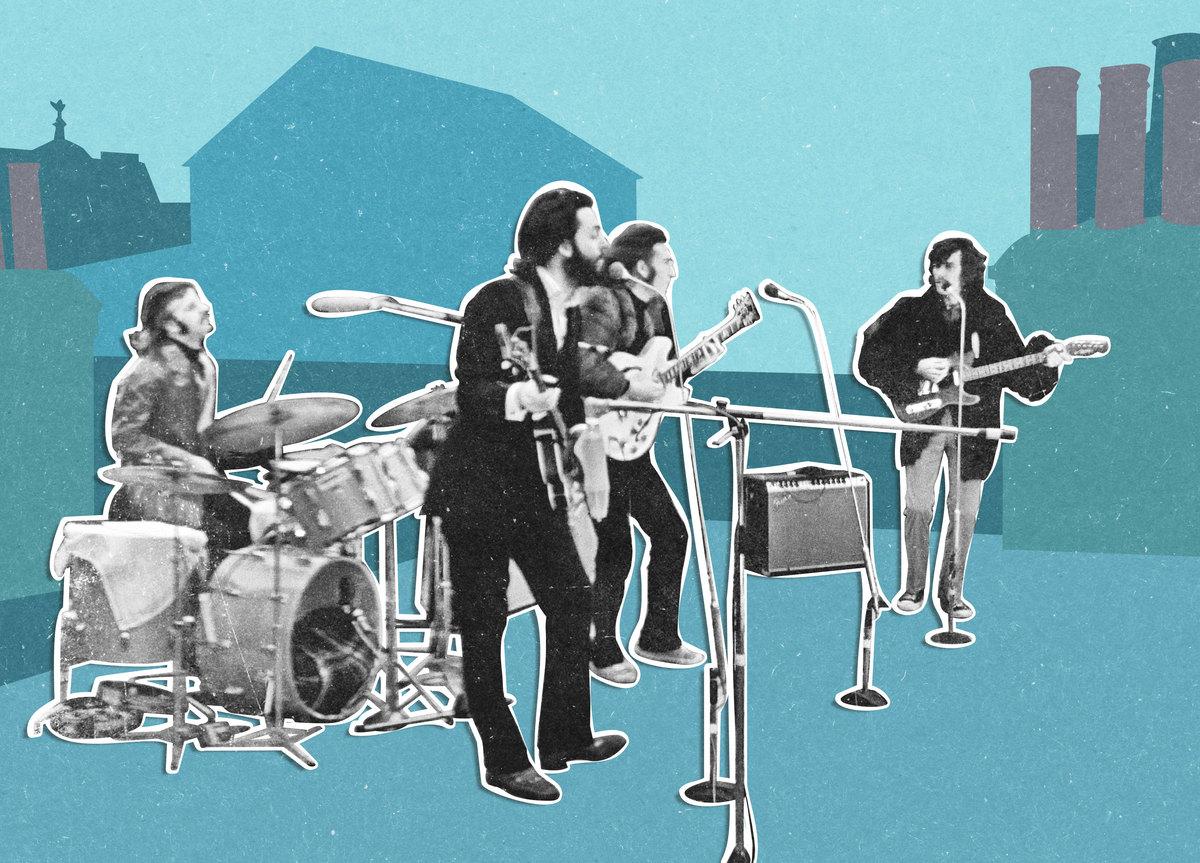
Looking back, so much of what the director Peter Jackson associates with the Beatles is the yearning. As a tween saving money for a model airplane in the early 1970s, he once walked by a store window, glimpsed the Beatles’ red and blue compilation albums, and immediately knew he needed to own them. (He never did buy that airplane, he told Deadline.) As an obsessive hobbyist by nature, he quickly accumulated more and more work by the Beatles, always seeking ever-holier grails: One film critic who crossed paths with the director in Wellington three decades ago wrote that Jackson once pointed to his wall and hoped that one day, it might be decorated with rare signed Fab Four album covers. And Jackson himself—speaking with reporters on Zoom ahead of the release of his latest project, the three-night documentary miniseries The Beatles: Get Back, which airs on Disney+ beginning this Thursday—reminisced about the days when he was just a young eager Beatles bootlegger, listening to whatever new-old scraps of bygone genius he could get his hands on and feeling frustrated that he couldn’t get so much more.
“The Get Back sessions’ bootlegs were interminable,” Jackson remembered. He was referring to some old audio from the Beatles’ January 1969 efforts to write and record a new batch of songs that they planned to debut at their first live show in years, audio that had been leaked and passed around among superfans like himself. Those bootlegs held an intriguing, if doomed, mystique because they had long been associated with the band’s breakup a year later. But to hear Jackson tell it, it wasn’t the music that made them a tough listen even for an enthusiast like him. It was all the things he couldn’t hear that hurt.
“You’d be trying to listen to conversations,” Jackson said, “and they’d be twanging guitars loud, and you’d be—it would be—you’d get annoyed because you’d half-hear the conversation, but the guitar would get in the way.”
So many snickered asides from George Harrison drowned out by some drumbeat! So many Paul McCartney proto-lyrics lost to reverb! Jackson, who was born in 1961, two years before the Beatles released their first album, said that he had always wished for a time machine: “You get one trip, what would it be?” he asked rhetorically on the Zoom call. His answer: “I’d say I wanna go back to the ’60’s. I’m not sure exactly what day. I’d have to think about that. I wanna go to the Beatles’ studio, and I just want to sit in the corner, not interfere, and just watch them work. That would be my time machine fantasy day.”
In reality, when it came to the Beatles, Jackson would wind up having a time-twisting fantasy that spanned much longer than a day. Following a series of conversations with the Beatles’ latter-day gatekeepers that began in 2017, Jackson was granted access to a trove of some 57 hours of video (and more than twice that of audio) from those weeks the Beatles spent in the studio in January 1969, as well as footage from the culmination of the Get Back sessions: a rogue Savile Row rooftop concert that was shut down by the cops and would ultimately be the band’s final show. For several years, Jackson could mostly be found squirreled away in a screening and editing room with his longtime collaborators, painstakingly watching, syncing, restoring, editing, and algorithmically sluicing all the components he’d been entrusted with—and in doing so, finally getting to hear these late-stage Beatles for all that they were.
The resulting project, The Beatles: Get Back, is an eight-hour, three-night spectacle that uncovers new territory by mining old ground. It combines the wonder of fresh eyes and ears with the institutional wisdom of an old head. (Also, John Lennon does dick jokes.) Sprawling in its confinement and generous in its conflict, Get Back peers into what had been known as a dim and uncertain time for the Beatles. And what it finds gives ancient lore both new life and new light, in a shine-on-till-tomorrow kind of way.
Watching intermittent scenes of The Beatles: Get Back that were provided in advance by the network, I had to give myself a mental pinch a few times: These aren’t actors! For one thing, the film has a built-in clock-ticking, calendar-X’ing-off story line—the band’s race to write and perform a bunch of new music—that feels tailor-made for narrative fiction or reality TV. For another, being one of the ultimate rock ’n’ roll stars means being, by definition, a character.
On both a visual and a content level, the four members of the band (as well as a fifth collaborator, Billy Preston, who stops by the Twickenham recording studio during the creative process) are rendered so clearly in Get Back doing things that are both so mundane and SO exceptional that it can be a struggle to remember that all these details weren’t workshopped, they just were. These aren’t the bowl-headed boys of the Please Please Me era, nor are they the caftan-wearing cast of Sgt. Pepper’s Lonely Hearts Club Band. In Get Back, what is striking about the Beatles is how often they just seem like dudes who happen to rock.
Ringo Starr looks like a costumed extra from Almost Famous. Harrison has the face of his son Dhani and an enormous black coat made from a Mongolian lamb. Lennon is iconically bespectacled and canonically horny, needling McCartney with some alternate lyrics that go “I’ve got a hard-on” and occasionally making out with Yoko Ono, whose divorce, we hear her say at one point, has just been finalized. (For the most part, Ono is more platonic, though she’s definitely quite proximate: For long stretches at a time, she sits nearby, knitting with the bored but reverent omnipresence of an MLB season ticket holder at a Tuesday doubleheader.) McCartney, calling out chords on the fly and fidgeting with his stache, is scruffy and a little bit poofy and bossy, but it’s mostly the good kind of bossy, the kind any wayward group needs someone to be if anyone is to get anything done.
And the Beatles, by 1969, were rather wayward. Their travels and their successes had taken them from their early-’60s post-schoolboy days in Liverpool and Hamburg to an across-the-universe sprawl that stretched from Shea Stadium to Rishikesh. They had kids and wives, and ex-wives and ex-managers, and new girlfriends and New Age gurus, and disagreements both with and on behalf of one another. They ranged in age from 25 to 28: They were practically babies, and they were definitely gods.
They hadn’t performed live since a world tour in 1966. They commissioned a director they had worked with before, Michael Lindsay-Hogg, to put together a documentary on their quest to return to the stage with new music; it was his team that shot the reels of footage that Jackson was later given access to. But by the time Lindsay-Hogg’s project, Let It Be, finally came out in 1970, it had been delayed (and meddled with by the band members) into oblivion. An attempt to blow up the film from 16mm to 35mm gave the finished product a grainy, muted feel. And what’s more, the Beatles had just broken up.
And so Let It Be, and the recording sessions that underpinned it, was long perceived as gloomy and grim, a cursed reflection of, or maybe even the reason for, the beloved band’s demise. This was something Jackson was compelled by, and it was something he kinda feared.
Originally, when Jackson started talking with the Beatles’ corporate entity, Apple Corps, it didn’t have to do with the Get Back sessions specifically. The band’s stewards instead wanted to pick his brain about a possible museum exhibit that might leverage the sort of virtual and augmented reality advances in production and moviemaking magic that Jackson has become synonymous with. (Some of his biggest projects include the sweeping and innovative Lord of the Rings trilogy and his jaw-dropping restoration, enhancement, and colorization of World War I footage in They Shall Not Grow Old.) “During that meeting,” he recalled over Zoom last week, “I didn’t want to act like a fan, but one of the things I’d always wondered about over the last 40 years is what happened to all the unused footage from Let It Be?”
When you’re Peter Jackson, ask and ye shall receive. But be careful what you wish for: Jackson, having gotten access to this otherwise unseen collection, found that it was extremely arduous to manage. Logistically, the video footage had been shot on two separate cameras without sound, while the audio tapes rolled separately, and for far longer. Figuring out how to accurately sync all this together took exquisite patience. But more existentially, Jackson was afraid of what they’d find once they pieced everything together. If those 22 days in January 1969 really were so explosive, he didn’t exactly look forward to watching the carnage as one of his favorite bands blew up.
What he didn’t expect was to find quite the opposite: something more like a band of brothers, simpatico on an almost cellular level, with all the familiar bickering and real love that such a kinship can provide. As Lennon remarks in the film: “All we have is us.” In Get Back, the four musicians banter and creatively iterate; they alternate between joyfully covering Bob Dylan and Chuck Berry and digging into their own half-finished jams, songs that would eventually show up on the albums Let It Be and Abbey Road. (While the two albums were recorded in that order, Abbey Road was released first, contributing to some of the lasting confusion over what constitutes the Beatles’ “breakup album.”)
They shed brilliance like skin cells. They invent, oh, you know, just the sonic landscape of my/your/Peter Jackson’s/everyone’s lifetime, messing around as if they’re a bunch of kids coming up with some new rules for tag. (In some ways, they are.) Starr’s thousand-yard-stare makes his magnificent drumming look even more like the work of a savant. Scraps of ideas wend their way into the annals of forevermore right before our eyes. “Is Tucson in Arizona?” Lennon asks at one point while McCarthy works on “Get Back,” and in another scene, he suggests that Harrison use “… attracts me like a cauliflower” as a lyrical placeholder in “Something.”
Not everything is perfect: The boys are also clearly weary and burned out and a little suspicious of their handlers. Harrison, feeling creatively stifled, quits for a few days and rejoins. We know, as viewers, that everyone’s time together is quickly barreling to a close. But what Jackson saw in his initial perusal was that there was still happiness in the ending, that not everything was the catastrophe it had developed a reputation for being.
Much of that reputation had come from inside the building. When Let It Be first came out, Lennon called the experience of putting it together “hell” and “six weeks of misery.” Starr, decades later, recalled “many heated discussions.” This summer, writing about a Hulu interview series between Paul McCartney and Rick Rubin, my Ringer colleague Ben Lindbergh mused, of the now-79-year-old Beatle: “Does he remember being in the Beatles, or is he remembering remembering being in the Beatles?” For Jackson, parsing the difference was the beauty of being able to go straight to the film.
First, though, there was that dang audio, back once again to annoy Jackson all these years after it first tantalized him on those old Get Back recordings he bootlegged. “The most depressing thing about this whole project at the beginning was the audio,” Jackson said last week about his new film. While his and his team’s work on They Shall Not Grow Old had given him a good idea of how he wanted to process and restore the 16mm video—“we developed a whole lot of software and code,” he explained—“it was like, ‘OK, well, it’s great, it’s fantastic, but God, I wish we could hear what they’re saying,’” Jackson said. He added that the band members a half-century ago were extremely aware that Lindsay-Hogg’s mics were frequently rolling, and responded by acting like the equivalent of two spies chatting by a loud waterfall.
“He’s just hiding mics in all places,” Jackson said of the Let It Be director. “This is, like, a battle of wills—they realize that he’s onto them. So, once they start having conversations, John and George in particular, they crank up the amp full max, and they just strum. And while they’re talking, they’re deliberately drowning out Michael’s microphones. And that’s sort of what you hear on the bootlegs.”
To counter that, Jackson’s team of “very clever people” in New Zealand developed what he called an “artificial intelligence, machine learning program” that could learn to parse the band’s mono tape recordings. “We digitize it, put it into the computer, teach the computer what a guitar sounds like, teach the computer what a human voice sounds like, teach them what a drum sounds like.” This was useful for cleaning up the tracks musically, but also for, as Jackson describes, letting the narrative thrust of his movie be determined by the Beatles themselves. “This de-mixing stuff that we’ve got, apart from cleaning up the songs,” Jackson said, also wound up “revealing 50-year-old conversations that they deliberately drowned out that no one’s ever heard before. So what that does is it allows us to hear the Beatles telling the story.”
In some ways, Get Back is reminiscent of one of the year’s most wonderful films, Summer of Soul, another sterling, stunning late-’60s music documentary that provides eye-popping footage that had been seen by no one for half a century. (Viva vaultcore!) In other ways, it pairs well with The Velvet Underground, the recent Todd Haynes documentary about a band that was a more esoteric, yet still hugely influential, contemporary to the Beatles. But unlike both films, Get Back eschews many typical documentary underpinnings—talking head interviews, historical pullbacks, keeping old film looking grainy, etc—because its goal is not to draw attention to the gulf between then and now, it is to eliminate it.
“Having this footage, I wanted everybody to feel it,” Jackson said. “So, I mean, that’s the reason why I didn’t put any modern-day interviews. I didn’t interview Ringo and Paul today remembering what happened. I didn’t want to make 50 years a thing.” Jackson doesn’t care about the proverbial time machine’s journey, in other words, only its destination. “I just wanted it to look almost as if we were in the room with them.”
When Jackson said this, it reminded me of something the guitar virtuoso Tim Reynolds told me back when I interviewed him for another story. It was about the first time he remembers feeling a thrill as a kid. One day, when his strict Pentacostal parents were out of the house, he and his sister put the Beatles on the record player and turned up the volume louder than their parents would have allowed. “It sounded like the band was in the house,” Reynolds told me, and the more he heard, the more he felt seen. (He remembers it as one of the first times he ever tried his hand at playing air guitar.) Get Back provides a complementary sort of vibe: Watching the band in such clarity, and at such length, makes for unforgettable listening. “You want to shout the lyrics at them,” Jackson said. “It’s very—it’s a strangely pure thing. It’s a strangely interactive experience.”

